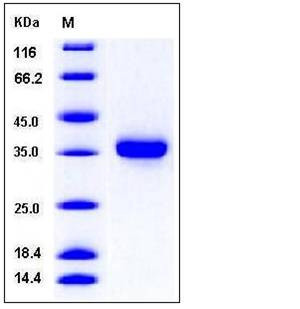Human KLK-8 / Kallikrein-8 Protein (His Tag)
HNP,NP,NRPN,PRSS19,TADG14
- 100ug (NPP4044) Please inquiry
| Catalog Number | P11820-H08H |
|---|---|
| Organism Species | Human |
| Host | Human Cells |
| Synonyms | HNP,NP,NRPN,PRSS19,TADG14 |
| Molecular Weight | The recombinant human KLK8 consists of 243 amino acids and predictes a molecular mass of 26.4 kDa. In SDS-PAGE under reducing conditions, the apparent molecular mass of rhKLK8 is approximately 36 kDa due to glycosylation. |
| predicted N | Gln 29 |
| SDS-PAGE |  |
| Purity | > 98 % as determined by SDS-PAGE |
| Protein Construction | A DNA sequence encoding the human KLK8 isoform 1 (O60259-1) (Met 1-Gly 260) was expressed, with a polyhistidine tag at the C-terminus. |
| Bio-activity | Measured by its ability to cleave the fluorogenic peptide substrate BocVPRAMC(Catalog # ES011). The specific activity is > 400pmoles/min/μg |
| Research Area | Immunology |Inflammation / Inflammatory Mediator |Plasma Cascade Systems in Inflammation |Fibrinolysis System |
| Formulation | Lyophilized from sterile PBS, pH 7.4 1. Normally 5 % - 8 % trehalose and mannitol are added as protectants before lyophilization. Specific concentrations are included in the hardcopy of COA. |
| Background | Kallikrein-8, also known as Neuropsin, Serine protease 19, Serine protease TADG-14, Tumor-associated differentially expressed gene 14 protein and KLK8, is a secreted protein which belongs to the peptidase S1 family and Kallikrein subfamily. It is a serine protease which is capable of degrading a number of proteins such as casein, fibrinogen, kininogen, fibronectin and collagen type IV. Kallikrein-8 / KLK8 plays a role in the formation and maturation of orphan and small synaptic boutons in the Schaffer-collateral pathway. It regulates Schaffer-collateral long-term potentiation in the hippocampus and is required for memory acquisition and synaptic plasticity. It is involved in skin desquamation and keratinocyte proliferation and plays a role in the secondary phase of pathogenesis following spinal cord injury. It also cleaves L1CAM in response to increased neural activity. It induces neurite outgrowth and fasciculation of cultured hippocampal neurons. Kallikrein-8 / KLK8 is expressed at high levels in serum, ascites fluid and tumor cytosol of advanced stage ovarian cancer patients and may serve as a marker of ovarian cancer. Kallikrein-8 / KLK8 may have potential clinical value for disease diagnosis or prognosis and it may also be a useful therapeutic target. |
| Reference |
